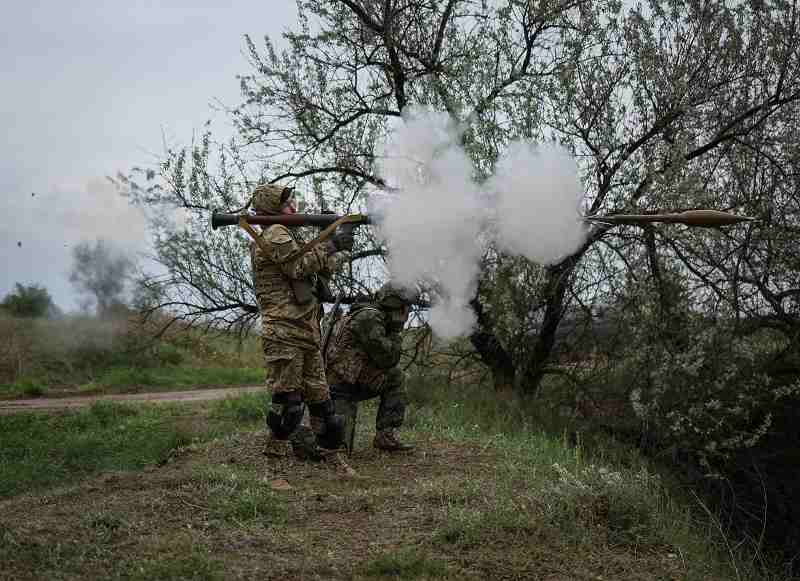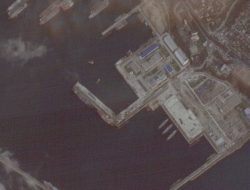
A Ukrainian serviceman of the Territorial Defence Forces fires a rocket-propelled grenade (RPG) launcher as part of a training exercise, amid Russia’s invasion of Ukraine, in Dnipropetrovsk region, Ukraine May 14, 2022.
10:01 JST, May 19, 2022
LONDON (Reuters) – Russia on Wednesday touted its new generation of laser weapons including a mobile laser system first announced by President Vladimir Putin in 2018 which Moscow said had advanced so far it could blind orbiting satellites and destroy drones.
Putin in 2018 unveiled an array of new weapons including a new intercontinental ballistic missile, a small nuclear warhead that could be attached to cruise missiles, underwater nuclear drones, a supersonic weapon and a laser weapon.
Little is known about what exactly the laser weapon, named Peresvet after a medieval Orthodox warrior monk Alexander Peresvet who perished in mortal combat, does. Putin gave few specifics in 2018 and the laser’s details are secret.
Yury Borisov, the deputy prime minister in charge of military development, told a conference in Moscow that Peresvet was already being widely deployed and it could blind satellites up to 1,500 km above Earth.
He cited a test on Tuesday which he said had burned up a drone 5 km away within five seconds. Reuters was unable to independently confirm the test.
“It is already being mass-supplied to the (missile) troops, and it can blind all satellite reconnaissance systems of a likely enemy in orbits of up to 1,500 km, disabling them during flight due to the use of laser radiation,” Borisov said.
“But that, let’s say, is of today, or even in some ways of yesterday: our physicists have now created, and practically mass-produced, laser systems which are more powerful by an order of magnitude that can inflict thermal destruction on various apparatus,” Borisov said.
Borisov’s remarks indicate that Russia has made significant progress with Peresvet, and other yet to be unannounced successors, a trend of considerable interest to other nuclear powers such as the United States and China.
His remarks indicate Russia could blind the satellites and an array of other systems which the United States uses to monitor Russia’s intercontinental ballistic missiles – or the drones used to target artillery positions in the Ukraine war.
Borisov said he had just returned from Sarov, a closed town in the Nizhny Novgorod region once known as Arzamas-16 because it was so secret, which is a centre of Russia’s nuclear weapons research.
“Today, so called weapons systems based on new physical principles are on the way,” Borisov said.
“This is primarily a laser weapon, an electromagnetic wideband weapon that will replace (conventional weapons) in the next decade – this is not some sort of exotic idea; it is the reality,” Borisov said.
"News Services" POPULAR ARTICLE
-

American Playwright Jeremy O. Harris Arrested in Japan on Alleged Drug Smuggling
-

Japan’s Nikkei Stock Average as JGB Yields, Yen Rise on Rate-Hike Bets
-

Japan’s Nikkei Stock Average Licks Wounds after Selloff Sparked by BOJ Hike Bets (UPDATE 1)
-

Japan’s Nikkei Stock Average Buoyed by Stable Yen; SoftBank’s Slide Caps Gains (UPDATE 1)
-

Japanese Bond Yields Zoom, Stocks Slide as Rate Hike Looms
JN ACCESS RANKING
-

Keidanren Chairman Yoshinobu Tsutsui Visits Kashiwazaki-Kariwa Nuclear Power Plant; Inspects New Emergency Safety System
-

Imports of Rare Earths from China Facing Delays, May Be Caused by Deterioration of Japan-China Relations
-

University of Tokyo Professor Discusses Japanese Economic Security in Interview Ahead of Forum
-

Tokyo Economic Security Forum to Hold Inaugural Meeting Amid Tense Global Environment
-

Japan Pulls out of Vietnam Nuclear Project, Complicating Hanoi’s Power Plans

























